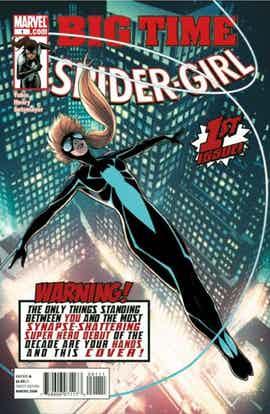
Under a blaring warning, the cover promises “the most synapse-shattering super hero debut of the decade.” I’m going to cry “Foul!” on that one. There have been more than a handful of character debuts in the past few years that would trump this one. The current “Batgirl” series springs to mind immediately, and I spent a good deal of time trying to parse out the differences between the two.
At first blush, my read on this book was that it rings out like a hollow version of “Batgirl,” but further scrutiny offered some variances to be celebrated. The lead characters, while both inspired by (arguably) the most recognizable character of their respective publisher are polar opposites of the spectrum in the personal lives, and it is that aspect that propels “Spider-Girl” to be so much more than a mere shadow of “Batgirl.”
Painfully socially inept, Anya asks Sue Storm about the process of making friends, a question that has some merit and sings out to my own thoughts. Life is much simpler the younger you are, but once you hit the teen years going up to someone and introducing yourself creates a level of discomfort for at least one – if not both – parties. This is just one example of how Tobin masterfully balances Spider-Girl’s world – and this issue – between heroism and teenaged drama while equally balancing Anya’s place between Spider-Man and the Fantastic Four.
Tobin balances Anya’s teenaged awkwardness with the bold bravado one would expect from a Spider-Man-inspired character. Anya is sassy during her fight with Screwball (yup, all of the good names are taken). Tobin also uses Twitter-like caption boxes to help the reader catch up with Spider-Girl in action. It’s a nice variation on the standard that plays well to the character and gives the book a modern flair.
Clayton Henry’s art is nothing short of breathtaking. Using a wide range of camera angles to play up the action and excitement of Anya’s lives, Henry doesn’t spare any detail. Anya’s pants have seams and the Corazon’s living room looks lived in. There is one spot where Sue Storm’s necklace disappears from one panel to the next, but, hey, it’s Sue Storm. She probably just made it invisible. Henry is a perfect match for this book that needs a credible, solid artist who can bring energetic figures, smart camera angles, and megatons of detail. It will be fun seeing what Henry shows us in upcoming issues. Chris Sotomayor brings the color magnificence I’ve come to expect from him, so much so that the floor in the library where Anya’s father is researching actually looks like berber carpeting.
The story doesn’t show its hand, so much so that it almost seems to simply meander, but it finds its way eventually through the convenience of comic book serendipity as Spider-Girl’s concerns for her father bring her to an exciting cliffhanger. This character is marginal enough to allow this title to do anything it wants – to a point, of course. It’s the same creative freedom that “Agents of Atlas” enjoyed, but this book is tied in to (no less than) two heroic pantheons and seems prepared to play those up for the benefit of fun stories and to the enjoyment of the reader.
This issue is finished off with a quaint backup story that tells of Gil Corazon’s relationship with the Fantastic Four. It makes for splendid supplemental material to the history of Spider-Girl while also playing off the main story with strong emotional ties. Dean Haspiel’s art is pitch perfect for the story of a young Anya Corazon, and I hope that we get to see more backups of this flavor in future issues.
The screaming cover blurb (and scene-stealing “Big Time” trade dress) aside, this book is fun, charming and a great heroic read that can be shared with the all ages scene quite nicely. My ten-year-old is an unabashed Spider-Fan, and this book has her tickled. As for me, I’m in. Swing on, Spider-Girl, swing on.

